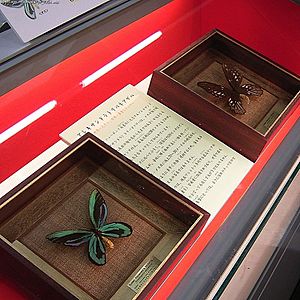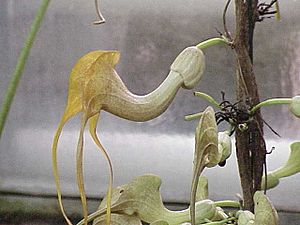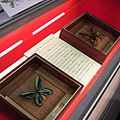Queen Alexandra's birdwing facts for kids
Quick facts for kids Queen Alexandra's birdwing |
|
|---|---|
 |
|
| Female (above) and male (below), not to scale | |
| Conservation status | |
| Scientific classification | |
| Kingdom: | |
| Phylum: | |
| Class: | |
| Order: | |
| Family: | |
| Genus: |
Ornithoptera
|
| Subgenus: |
Straatmana
Deslisle, 2007
|
| Species: |
O. alexandrae
|
| Binomial name | |
| Ornithoptera alexandrae Rothschild, 1907
|
|
The Ornithoptera alexandrae, also known as the Queen Alexandra's birdwing, is the biggest butterfly in the world! Female butterflies can have wingspans a bit larger than 25 centimeters (about 9.8 inches). This amazing birdwing butterfly lives only in the forests of the Oro Province in eastern Papua New Guinea.
This special butterfly is an endangered species. It is one of only three insects listed on Appendix I of CITES. This means it is against the law to trade these butterflies internationally.
Contents
Discovering the Queen Alexandra's Birdwing
This butterfly was first found in 1906 by Albert Stewart Meek. He was a collector who worked for Walter Rothschild. Rothschild hired him to find natural history items in New Guinea. The next year, Rothschild named the butterfly after Alexandra of Denmark.
The first butterfly specimen was caught using a small shotgun. But soon after, Meek found the butterfly's early life stages. This allowed him to raise many of the first specimens.
What Does the Queen Alexandra's Birdwing Look Like?
This butterfly shows a clear difference between males and females, which is called sexual dimorphism.
Female Queen Alexandra's Birdwing
Female Queen Alexandra's birdwings are larger than the males. Their wings are also more rounded and wider. A female can have a wingspan of over 25 centimeters (9.8 inches). Her body can be 8 centimeters (3.1 inches) long and weigh up to 12 grams (0.42 ounces). These are huge sizes for a butterfly!
The female has brown wings with white markings that look like two rows of "V" shapes. Her back wings are brown with a line of yellow triangles near the edge. Her body is cream-colored, and she has a small patch of red fur on her brown chest area.
Male Queen Alexandra's Birdwing
Male Queen Alexandra's birdwings are smaller than females. Their wings are long and have pointed tips. They are a shiny bluish-green color with a black stripe in the middle. The underside of their wings is green or blue-green with black lines.
The male's body is bright yellow. Their wingspan can be around 20 centimeters (7.9 inches), but it is usually about 16 centimeters (6.3 inches). There is a very striking type of male called atavus. This form has gold spots on its back wings.
Life Cycle of the Queen Alexandra's Birdwing
Eggs
The eggs of this butterfly are large and light yellow. They are flat at the bottom and stick to the surface where they are laid with a bright orange substance. If conditions are good, a female Queen Alexandra's birdwing can lay more than 240 eggs during her life.
Larva (Caterpillar)
When a larva (caterpillar) first hatches, it eats its own eggshell. Then, it starts to eat the leaves of specific plants called pipevines from the Pararistolochia genus. These plants include P. dielsiana and P. schlecteri. The caterpillars eat the fresh leaves and even their own eggs. They can eat so much that they damage the vine before they change into a pupa.
These pipevine plants contain special chemicals called aristolochic acids. The caterpillars store these chemicals in their bodies as they grow. These chemicals are thought to be a strong poison for animals with backbones.
Pupa
The pupa (chrysalis) is golden yellow or tan with black marks. You can tell male pupae apart by a faint dark patch on their wing cases. This patch will become a special band of scales on the adult butterfly called a sex brand.
It takes about six weeks for this butterfly to grow from an egg to a pupa. The pupa stage itself lasts for a month or more. Adult butterflies come out of their pupae early in the morning. This is when the air is still very humid. Their huge wings might dry out before they can fully open if the air is too dry.
Adult Butterfly
Adult Queen Alexandra's birdwings can live for three months or even longer. They have few natural enemies, mostly large orb-weaving spiders and some small birds.
Adult butterflies eat nectar from flowers that have a wide flat surface for them to land on, like Hibiscus flowers. They are strong flyers and are most active in the early morning and again at dusk when they feed.
Male butterflies also fly around the host plants in the early morning looking for females that have just come out of their pupae. Females can be seen searching for host plants for most of the day to lay their eggs.
The courtship between males and females is quick but amazing. Males hover above a female they are interested in. They release a special scent called a pheromone to encourage her to mate. If the female is ready, she will let the male land and mate. If not, she will fly away or show she is not interested.
Male butterflies are very protective of their area. They will chase away other male butterflies and sometimes even small birds! These butterflies usually fly high up in the rainforest trees. However, both males and females will fly lower to the ground when they are feeding or laying eggs.
Images for kids
See also
 In Spanish: Mariposa alas de pájaro de la reina Alexandra para niños
In Spanish: Mariposa alas de pájaro de la reina Alexandra para niños






